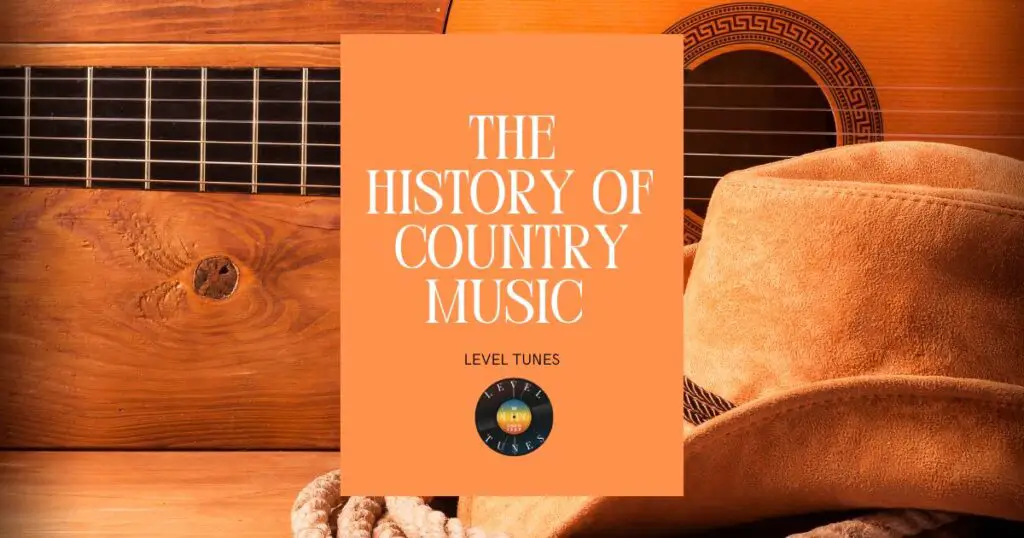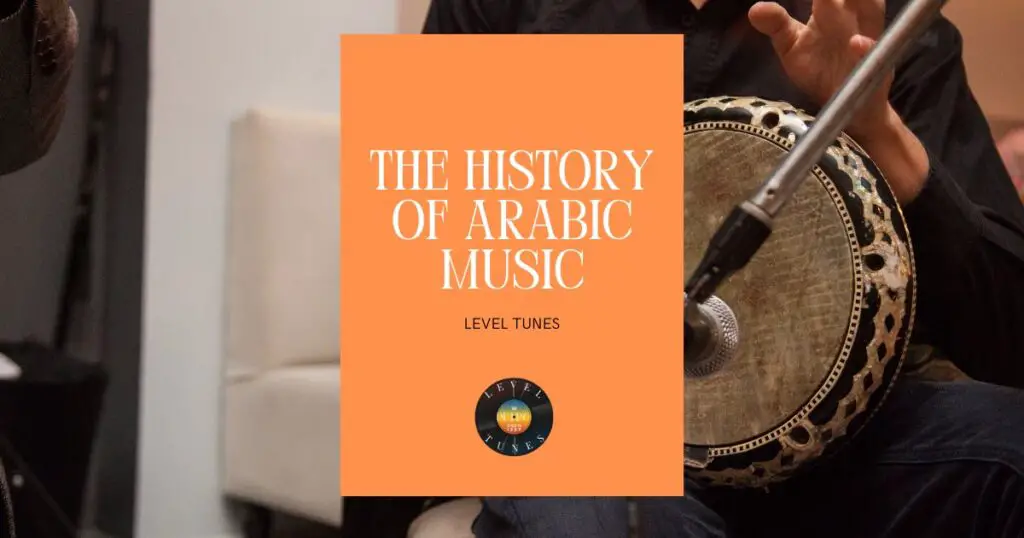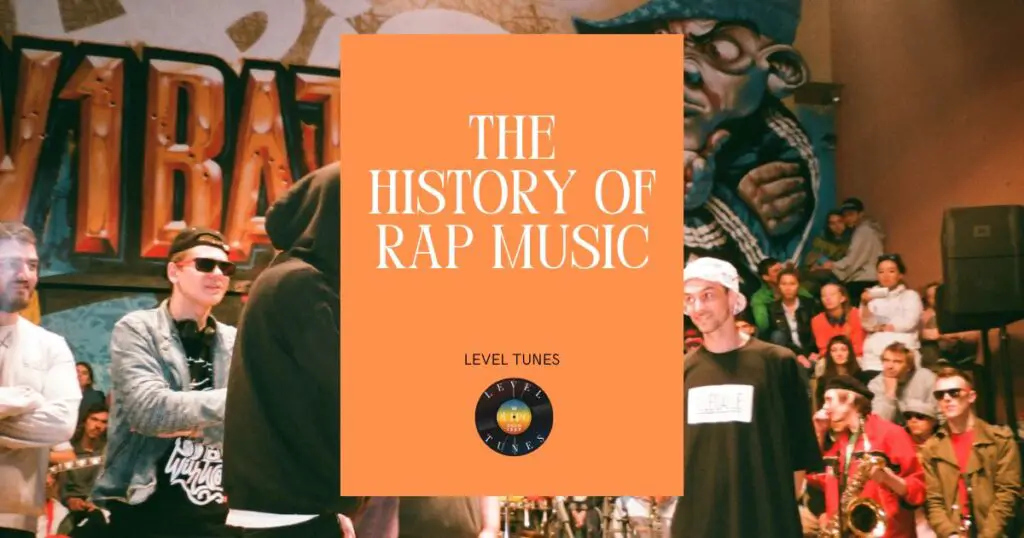From the humble beginnings of folk tunes echoing through the Appalachian Mountains to the chart-topping hits gracing our screens today, country music has a rich history filled with working-class stories and heart-wrenching melodies.
Born in the rural southern United States, this beloved genre is often considered America’s soundtrack, blending various cultural influences into its distinct sound.
In this blog post, we invite you on a musical journey through time as we explore the fascinating story of country music – from its early roots and commercialisation to current global appeal.
Key Takeaways
- Country music originated in the Southern United States and is characterized by working – class themes, blending diverse cultural influences into its distinct sound.
- Its roots can be traced back to Anglo – Celtic folk tunes, blues, gospel hymns, work songs and popular music; it emerged from humble beginnings to become an integral part of American popular music.
- The Grand Ole Opry played a significant role in promoting country music while recording technology and radio broadcasting paved the way for commercialization. Honky-tonk emerged as a popular sub-genre during the Golden Age of country music in Nashville.

What Is Country Music?
Country Music is a genre of music that originated in the Southern United States, characterized by working-class themes and influences, such as ballads, folk songs, and Appalachian fiddle tunes.
Definition And Origin
Country music, also known as hillbilly or western music, had its roots firmly planted in the rural regions of the South and West in America. Its humble beginnings can be traced back to old-time music from early Southern Appalachian fiddle players who made their first recordings in the late 1910s.
As I delved deeper into this charming genre steeped with working-class culture, I discovered that it is widely recognised for touching on relatable themes such as love, heartbreak and nostalgia – making it one of the first modern American popular forms of expression.
For example, legendary artists like Johnny Cash sang about his experience growing up poor while Loretta Lynn shared her stories about life as a coal miner’s daughter.
Working-Class Themes And Influences
As a passionate music lover, it’s hard not to be captivated by the rich history and powerful themes of country music. At the heart of this genre lies its connection to working-class values and experiences that have resonated with listeners throughout generations.
One might say that these working-class themes give country music its soul. For example, Merle Haggard’s “Workin’ Man Blues” is a tribute to the daily grind faced by many blue-collar workers who provide for their families while struggling through economic hardships.
Meanwhile, Dolly Parton’s “9 to 5” captures the frustration faced by millions in monotonous day jobs yearning for something more fulfilling. Other artists like Johnny Cash and Loretta Lynn have touched on topics such as poverty or relationship struggles without sugarcoating them but remaining grounded in authenticity – making country music truly relatable for so many people across different walks of life.
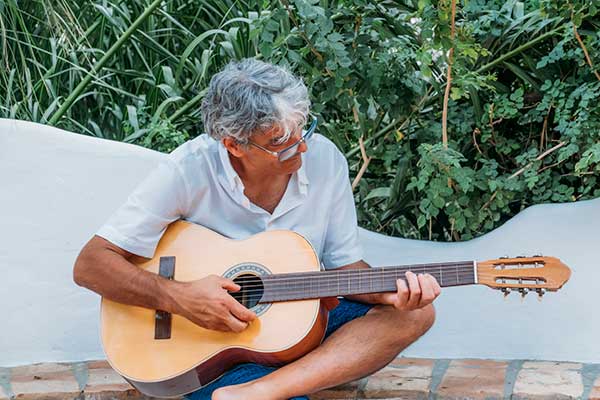
Early Roots Of Country Music
Early country music was heavily influenced by folk music and the traditional songs of Appalachia, as well as the distinct western swing sound.
Folk Music Influences
Delving into the rich tapestry of country music, it’s impossible to ignore the profound impact that folk music has had on its development. Folk music, with its captivating storytelling and deep-rooted traditions, provided a solid foundation for country music as we know it today.
The British Isles played a particularly significant role in shaping the early sounds of country music. English, Scots and Irish settlers who inhabited the southeastern regions of the United States introduced ballads brimming with emotion and tales of both love and tragedy.
These heartfelt stories resonated deeply within working-class communities who could relate to these timeless themes – giving birth to what would become known as “roots music”.
Artists such as Jimmie Rodgers and The Carter Family were among some of the first pioneers who blended elements from these diverse styles which formed what we now recognise as classic country sounds.
Their emotive storytelling connected with audiences across all strata by effortlessly merging rural folklore with stirring instrumentation like banjos, fiddles or harmonicas.
Traditional Country Music From The 1920s And 1930s
In the early 1920s and 1930s, traditional country music began to be commercially recorded and distributed across America. This type of music had its roots in southern string-band music, old-time music, Appalachian music, and other genres that were popular in the mountain regions.
The genre gained popularity through recordings of the Carter family and Jimmie Rodgers.
One significant aspect of traditional country was its emphasis on personal storytelling through harmonious tunes using fiddles and guitars. The lyrics usually reflected the folk traditions highlighting human experiences rather than abstract concepts like politics or economics.
As a result of this recording industry boom for traditional country musicians between 1923-1933 due to advancements in technology made it possible to capture these sounds on wax cylinders so people who couldn’t listen live could still enjoy them at home via radio broadcasts or records!
Western Swing
As a music lover, you might have come across the term “Western Swing” in discussions about early country music. Western swing originated in Texas during the late 1920s and combined traditional fiddling, swing band jazz, Mexican songs, and blues to create a popular dance music.
Western swing evolved as a response to the emergence of commercialized country music’s focus on polished, pop-oriented sounds. It was also considered an important influence on early country music development- particularly with Bakersfield sound that emerged in California during the 1970s.
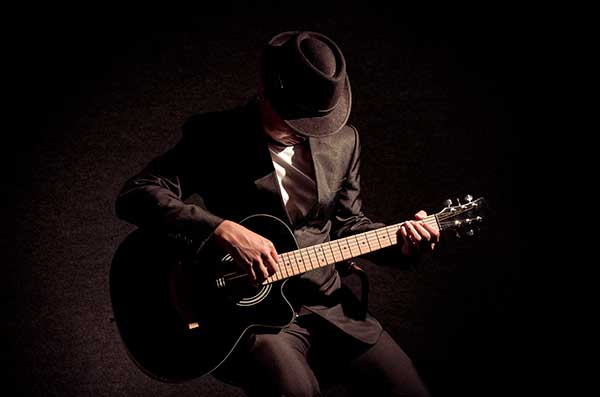
The Commercialization Of Country Music
Country music became more commercialized in the 1920s and ’30s thanks to recording technology and the rise of radio, which gave artists wider audiences.
The Bristol Sessions And The Birth Of The Recording Industry
When looking at the history of country music, it’s impossible not to mention the Bristol Sessions and their impact on the recording industry.
In 1927, Ralph Peer set up a field unit for the Victor Talking Machine Company in Bristol, Tennessee/Virginia to record local musicians.
The sessions brought together various artists who had been playing regionally with little recognition. Among them were The Carter Family, Jimmie Rodgers and Ernest Stoneman.
These sessions resulted in over 70 songs being recorded that spread across America through radio play and records sales. This was groundbreaking because before then, few regional musicians or genres made it beyond their immediate surroundings.
For instance, Buddy Bolden is known as one of jazz’s founding fathers but there are no surviving recordings or even images since his fame never extended beyond New Orleans where he was active creatively around 1900 AD.
It paved the way for commercialization while fostering new innovations in sound and style which eventually led to its own genre – Country Music.
The Grand Ole Opry And The Rise Of Radio
I love the Grand Ole Opry and feel that it’s a significant part of country music history. The Opry started in 1925 when George D. Hay, a radio editor for Memphis Commercial Appeal, decided to create a show that would celebrate the tradition of Southern folk music.
Radio broadcasting was instrumental in creating the popularity of country music, and Nashville’s emergence as its hub could be attributed to Radio station WSM and its strong signal strength that reached out far beyond Tennessee.
At first, there were only six performers on staff at the Grand Ole Opry; now, there are hundreds of entertainers who have graced its stage over time – from Patsy Cline to Minnie Pearl to Johnny Cash- all contributing their unique sound and perspective on country music genre.
Singing Cowboys In Hollywood
As country music grew in popularity, Hollywood took notice and began incorporating the genre into their films. The result was the emergence of singing cowboys on the big screen – a subtype of the archetypal cowboy hero that referenced real-world campfire side ballads in the American frontier.
Gene Autry, Roy Rogers, and Tex Ritter were among some of the most popular singing cowboys who brought country songs to an entire nation for the first time.

The Golden Age Of Country Music
During the Golden Age of Country Music, honky-tonk emerged as a popular sub-genre in the 1940s and Nashville solidified itself as a country music hub.
Honky Tonk And The Emergence Of Nashville As A Country Music Hub
During the 1940s, Nashville became the epicentre of country music in America. The honky-tonk era is considered to be the “Golden Age of Country Music,” and it was during this time that honky-tonk style became the most popular form of country music.
Honky-tonk music evolved from ragtime piano styles but focused more on rhythm than melody. It had a distinctive sound characterised by its use of acoustic and pedal steel guitars and fiddles alongside other instruments.
As these musicians began to make headway in Nashville’s competitive scene, they helped establish Nashville as a hub for country music – one that still thrives today.
The Nashville Sound And Country-Pop
The Nashville Sound emerged as a subgenre of country music in the mid-1950s, bringing a more polished and pop-oriented sound to the genre. The main objective was to create crossover hits that could appeal to mainstream audiences while still retaining elements of traditional country.
Producers used string sections, backing vocals, and smooth arrangements borrowed from pop music to achieve this goal. Stars like Jim Reeves, Brenda Lee, and Patsy Cline were emblematic of the movement’s success.
Country-Pop continued this tradition into the 1970s with artists such as Glen Campbell, John Denver and Kenny Rogers achieving unprecedented commercial success by blending country instrumentation with easy-to-digest melodies that appealed beyond traditional country fanbases.

Country Music And Social Change
Outlaw Country emerged in the 1960s and 70s, with artists like Willie Nelson and Waylon Jennings seeking to break away from Nashville’s commercial sound.
Outlaw Country And The Civil Rights Era
As the Civil Rights Era was bringing significant societal change, country music was also undergoing a transformation. Outlaw Country emerged in the 1970s as a subgenre that challenged the traditional Nashville sound and represented an alternative to mainstream country music.
Outlaw Country’s connection to civil rights lay in its representation of a mythopoetic male movement seeking authenticity and rebellion against perceived corporate control.
While not explicitly political or campaigning for social change, Outlaw Country exemplified rebellion during this era of radical shifts in American society.
Women In Country Music
As a music lover, you cannot discuss the history of country music without acknowledging the significant role women have played in shaping and evolving the genre.
From being token band members to rising as superstar soloists, women’s presence in country music has come a long way. Sarah Carter was one of the pioneers who helped bring change to gender roles in country music early on.
Many iconic female singers and songwriters such as Patsy Cline, Loretta Lynn, Dolly Parton, Reba McEntire and Kacey Musgraves have made their mark on country music history through chart-topping hits and Grammy Awards wins.

The 1980s And 1990s: New Country And Crossover Success
The 1980s and 1990s saw the rise of new country artists, such as Garth Brooks and Shania Twain, who brought a fresh sound to the genre. With crossover success into popular music charts, these artists helped to reinvigorate interest in country music for a new generation.
The Rise Of Garth Brooks And Shania Twain
In the 1990s, the country genre saw a significant shake-up with the rise of new artists like Garth Brooks and Shania Twain. Brooks, in particular, was credited with bringing rock and pop elements into country music with his energetic live shows and catchy hooks.
Influence Of Movies And TV Shows
Movies and television shows have played an important role in the popularity of country music. During the 1980s and 1990s, many country artists had their songs featured on popular TV shows and movies, which helped to increase their visibility beyond just traditional country music fans.
Garth Brooks is a prime example, with his hit song “Friends in Low Places” appearing on several TV shows and films.
Other country stars found success outside of their music careers through acting roles on TV and in film. Dolly Parton starred in several films throughout the 80s and early 90s while also enjoying chart-topping success as a singer-songwriter.
Women were particularly successful during this era, with crossover superstar Shania Twain landing her own reality show after selling millions of records across both pop and country charts.
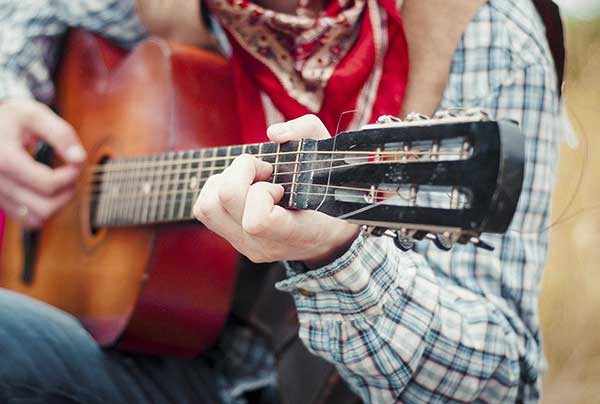
Contemporary Country Music
Contemporary country music has been influenced by pop and hip-hop, as well as incorporating the traditional sound of neo-traditionalism.
Pop And Hip-Hop Influences
As contemporary country music continues to evolve, it’s clear that pop and hip-hop influences are playing a significant role. Many of today’s biggest country stars owe their success to cross-genre collaborations and fusions of sound.
One example is Florida Georgia Line, who gained fame with their hit “Cruise,” featuring rapper Nelly.
It’s not just about collaboration either – some artists are incorporating audio production techniques from other genres into their own music. For instance, electronic beats and auto-tune have become more prevalent in modern country songs thanks to the influence of pop and R&B music.
Bro Country And Criticisms Of The Genre
One controversial sub-genre of country music that has gained popularity in recent years is bro-country. This style of music features partying, beer-drinking and women as its primary themes and is often criticized for perpetuating negative stereotypes about rural life.
However, others point out that bro-country is simply a reflection of the tastes of its listeners and note that critics have been making similar complaints about other styles of music for decades.
Despite this back-and-forth debate, one thing is clear: bro-country continues to be popular with many fans of contemporary country music.
Traditional Country Sound And The Neo-Traditionalist Movement
When it comes to country music, traditionalism plays a significant role. The traditional country sound is often associated with the ‘Neo-Traditionalist Movement.’ This movement saw young artists write their own material and have unique voices, creating a new style of music that ultimately became one of the dominant strains of country music in the 1990s and into the 2000s.
Despite these debates, neotraditional country continues to be appreciated by many fans who value its authenticity and dedication to preserving the classic sounds of honkytonk and outlaw country.
Some notable artists who emerged from this movement include George Strait, Alan Jackson, Brooks & Dunn, among others.

International Country Music Scenes
Countries outside of the United States also have thriving country music scenes, including Australia, Canada, and Europe.
Australia And New Zealand
As a music lover, you’ll be interested to know that country music has deep roots in Australia and New Zealand dating back to the early days of European settlement.
Over time, the genre has taken on its own unique character reflecting local styles and traditions. In New Zealand, for example, Maori influences can be heard in songs while Australian country music often features stories about rural life.
Tamworth, Australia’s “Country Music Capital,” hosts an annual festival that is famous around the world for showcasing both established performers and up-and-comers from across Australia as well as international guests.
Canada
As a music lover, it’s important to recognize the rich and diverse musical culture of Canada. From Celtic and country music to jazz and blues, Canada has been home to many notable musicians.
When it comes specifically to country music, Canada boasts some truly fantastic artists who’ve made significant contributions to its history and growth. Shania Twain is arguably one of the most famous Canadian country singers around; she’s sold millions upon millions of records worldwide thanks to her catchy pop-infused take on country tunes.
Europe And The UK
As country music has spread beyond the borders of America, it has found a home in many parts of Europe and the UK. In countries like Ireland and Scotland, traditional folk influences can be heard in modern takes on country music.
Australian artists such as Keith Urban have made their mark on the country scene, while Canadian acts like Shania Twain and Paul Brandt have achieved international success.
One example of country music’s global reach is Nashville Meets London, an annual festival that brings together American and British musicians for three days of live performances.
The event has drawn crowds of thousands since its inception in 2016 and highlights the shared passion for storytelling through music between these two nations.
Recognizing Country Music Achievements
The Country Music Association Awards and other honors are important in recognizing country music achievements, while country music festivals and events provide a platform for showcasing new talent.
The Country Music Association Awards And Other Honors
As a country music fan, it’s essential to recognize the amazing achievements of artists in the industry. One way this is done is through the prestigious Country Music Association (CMA) Awards.
What makes these awards so unique is that they are voted on by members of the CMA – individuals who work within all sectors of the industry. In addition to these awards, there are other honors given out throughout the year to celebrate those who have contributed significantly to country music.
For example, The Jeff Walker Global Country Artist Award recognizes artists signed outside of North America for their contributions to country music worldwide.
These awards show just how diverse and exciting country music can be while honoring both established icons and up-and-coming stars alike!
Country Music Festivals And Events
If you love country music, there are plenty of festivals and events that you can attend to get your fix. From the biggest annual events to smaller local gatherings, here are some of the best country music festivals and events around:
- The Country Music Association Awards – this annual awards show recognizes the best in country music and is broadcast live on TV.
- Stagecoach Festival – one of the biggest country music festivals in the US, featuring top acts like Luke Bryan, Carrie Underwood, and Thomas Rhett.
- CMA Fest – a four-day event held in Nashville featuring concerts, fan meet-and-greets, and other activities.
- Calgary Stampede – an iconic Canadian festival that features rodeos, chuckwagon races, and plenty of live country music performances.
- Tamworth Country Music Festival – Australia’s largest country music festival, featuring hundreds of performances across multiple stages.
- The Americana Music Festival – a multi-day event held in Nashville that showcases a variety of genres including folk, blues, and rock alongside traditional country.
- Farm Aid – an annual benefit concert for family farmers featuring top names in country music like Willie Nelson and John Mellencamp.
- The Grand Ole Opry – this legendary venue hosts live radio broadcasts featuring both established stars and up-and-coming artists.
- Faster Horses Festival – a Michigan-based festival that celebrates all things country with camping, food vendors, activities and non-stop live entertainment
- Hickstead Derby Meeting– Country Horse Show jumpers from across world come together for this regional horse show event hosted annually at Hickstead – West Sussex
Whether you’re a die-hard fan or just looking to discover some new artists, attending these festivals can be an amazing experience full of great music and good times!
Conclusion
In conclusion, the history of country music is a fascinating story that reflects the melting pot of cultures in America. This genre emerged from humble beginnings to become an integral part of American popular music.
It started as ballads and folk songs passed down through generations, blending English, Scots, and Irish influences with Appalachian fiddle tunes and work songs. Today’s country music scene continues to be influenced by other genres such as pop and hip-hop but still carries its roots in traditional country sound.
Its heritage remains strong as it brings people together around common values like family, hard work, love for their land and traditions.
Thanks for reading.
TBone

